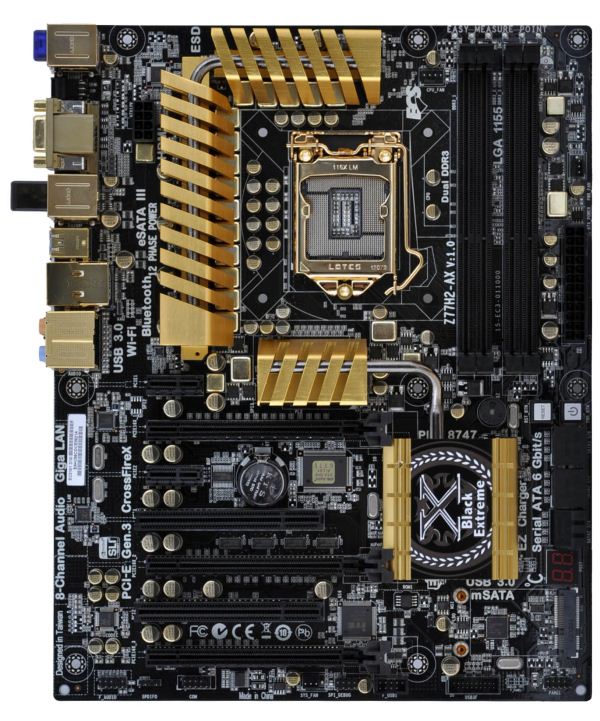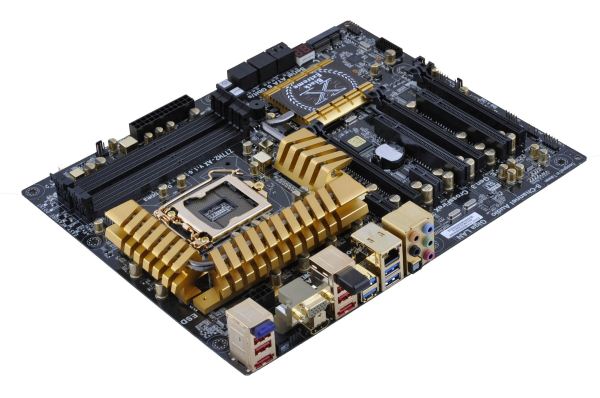Intel Z77 Panther Point Chipset and Motherboard Preview – ASRock, ASUS, Gigabyte, MSI, ECS and Biostar
by Ian Cutress on April 8, 2012 12:00 AM EST- Posted in
- Motherboards
- Intel
- Biostar
- MSI
- Gigabyte
- ASRock
- Asus
- Ivy Bridge
- ECS
- Z77
ECS Z77H2-AX—Visual Inspection
If all you ever wanted in life was something colored gold, I think ECS have you covered. As part of their Golden Board branding, the ECS Z77H2-AX has been plated with a layer of gold paint. Well, their heatsinks, heatpipes, socket, capacitors, VRMs and IO panel have all had a layer of gold paint added in order to improve aesthetics. When I first took this board out of the wrapper, I was figuratively blinded by just how much of the gold color was in my face.
Initially ECS will be releasing two high-end Z77 boards, with this one being the most expensive we have in for review, at an MSRP of $319. As such, I would expect it to perform near the top in almost every aspect—features, extras, performance and usability. As more than twice the price of the ASRock Z77 Extreme4, it had better be at least twice the board.
For a start, we can see that the socket is closed in, with the heatsinks and the memory slots being right up against Intel's minimum required socket spacing. This means big air coolers may not get a chance to fit, and only stock or water-cooling need apply. If that is the case, then I hope ECS have a robust overclock system in place.
One thing to feel disappointed by the ECS board though is the lack of fan headers. Around the socket you are lucky to have two—one 4-pin between the top VRM heatsink and the memory slots, and a 3-pin just above the 24-pin ATX power connector. A solitary third is on the bottom of the board. In the past ECS fan OS controls have had some of the better software support; however, it does not make sense to have only three headers on this.
Down the right hand side of the board, below the ATX power connector, are a pair of power/reset buttons, the standard six SATA ports from the PCH, and a two-digit debug display. Note we do not have any other SATA controllers for internal ports on the board. Below the two-digit debug display is an mSATA connector, which doubles up as a mini-PCIe if a user want to use a WiFi module (note, there is one on board already) or a TV Tuner.
On the south side of the board we are not given a vast amount of headers to say it is cramped—aside from standard front panel headers, there is a USB 3.0 header, a COM header, and a solitary USB 2.0 header.
This big selling point of this board over the other boards in this preview however is its multi-GPU capabilities. ECS have decided to invest in a PLX PXE 8747 chip, which is akin to the NF200 chips we saw on X58. This chip will expand the 16 PCIe 3.0 lanes on the board to 32, meaning that on the PCIe slots, we can have x16/x16 in dual card mode, or x16/x8/x8 in tri-card mode.
Thus in order we have an x1, an x16, x1, PCI, x16/x8, PCI, x8. So if all three full length PCIe slots are filled, there is still access to an x1 and a PCI, but we lose a lot of the functionality on the south part of the board.
The back panel has a mix and match of capabilities and functionality. From the left, we have a Bluetooth dongle, two USB 2.0 (red), an eSATA, a clear CMOS button, D-Sub, HDMI, a WiFi dongle, two USB 2.0, an eSATA, two USB 3.0, gigabit Ethernet, two USB 3.0, optical SPDIF and audio jacks. The big selling point for me is the WiFi, which ECS have cunningly added to their top range boards for a few chipsets now.
Board Features
| ECS Z77H2-AX | |
| Size | ATX |
| CPU Interface | LGA-1155 |
| Chipset | Intel Z77 |
| Power Delivery | 12 + 2 |
| Memory Slots |
Four DDR3 DIMM slots supporting up to 32 GB Up to Dual Channel, 1066-2800 MHz |
| Video Outputs | HDMI, D-Sub |
| Onboard LAN | Realtek 8111E |
| Onboard Audio | Realtek ALC892 |
| Expansion Slots |
2 x PCIe x16 Gen3 (x16, x8/8) 1 x PCIe x16 Gen2 (x4) 2 x PCIe x1 Gen2 2 x PCI |
| Onboard SATA/RAID |
2 x SATA 6 Gbps (PCH), Support for RAID 0, 1, 5, 10 4 x SATA 3 Gbps (PCH), Support for RAID 0, 1, 5, 10 2 x eSATA 3 Gbps |
| USB |
6 USB 3.0 ports (4 back panel, 2 from headers) 6 USB 2.0 ports (4 back panel, 2 from headers) |
| Onboard |
2 x SATA 6 Gbps 4 x SATA 3 Gbps 1 x USB 3.0 Header 1 x USB 2.0 Header 3 x Fan Headers 1 x COM Header 1 x SPDIF Output Header 1 x Front Panel Audio Header Power/Reset Buttons Debug LED 1 x mSATA |
| Power Connectors |
1 x 24-pin ATX connector 1 x 8-pin 12V connector |
| Fan Headers |
1 x CPU Fan Header (4-pin) 1 x SYS Fan Header (3-pin) 1 x PWR Fan Header (3-pin) |
| IO Panel |
4 x USB 3.0 Ports 4 x USB 2.0 Ports 1 x HDMI 1 x D-Sub 1 x Gigabit Ethernet 1 x Optical SPDIF Output 1 x Clear CMOS Button 1 x Wifi Connector 1 x Bluetooth 2 x eSATA 3 Gbps Audio Ports |
| Warranty Period | 3 Years from date of Purchase (3yr parts, 2yr labor) |
| Product Page | Link |
Despite having WiFi, mSATA and extended PCIe 3.0 lanes, the ECS board is down on audio (Realtek ALC892 rather than ALC898 of others), lacking fan headers and also lacking video outputs, with a lot of people requiring DVI to D-Sub or DVI to HDMI connectors.













145 Comments
View All Comments
DanNeely - Monday, April 9, 2012 - link
This is similar to what happened with the USB1->2 transition. The newer controller is significantly bigger (read more expensive) and very few people have more than one or two devices using it per computer. I suspect the 8x (Haswell) chipset will be mixed as well; simply because the total number of ports on the chipset is so much higher than it was a decade ago (vs older boards were all but the lowest end models added more USB from 3rd party controllers).ASUSTechMKT - Monday, April 9, 2012 - link
mSATA currently has very little penetration on the market and cost wise it is much lower to purchase a larger cache SSD for the same or lower cost. We would prefer to focus on bringing implementations that offer immediate value to users.As for the Intel nics all our launch boards across the board for ATX ( Standard and above all feature Intel lan ) we have been leading in this regard for a couple of generations.
In regards to USB 3 we offer more than the standard on many boards but keep in mind many users only have 1 USB3 device.
jimnicoloff - Sunday, April 8, 2012 - link
Maybe I missed something from an earlier post, but could someone please tell me why these don't have light peak? Are they waiting to go optical and it is not ready yet? Having my USB3 controlled by Intel instead of another chip is not enough to make me want to upgrade my Z68 board...repoman27 - Sunday, April 8, 2012 - link
Thunderbolt controllers are relatively expensive ($20-30) and their value is fairly limited on a system using a full size ATX motherboard that has multiple PCIe slots. Including two digital display outputs, an x4 and a couple x1 PCIe slots on a motherboard provides essentially all the same functionality as Thunderbolt but at a way lower cost.ASUSTechMKT - Monday, April 9, 2012 - link
Almost all of our boards feature a special TB header which allows for you to easily equip our boards with a Thunderbolt add on card which we will release at the end of the month. Expect an approximate cost of $40 dollars, this card will connect to the TB header and install in a X4 slot providing you with Thunderbolt should you want it. A great option for those who want it and for those who do not they do not pay for it.DanNeely - Tuesday, April 10, 2012 - link
Sounds like a reasonable choice for something that's still rather expensive and a very niche product.Am I correct in thinking that the mobo header is to bring in the DisplayPort out channel without impacting bandwidth available for devices?
jimwatkins - Sunday, April 8, 2012 - link
I've made it this far on my venerable OC Q6600, but I can't wait any longer. I do wish they weren't so stingy on the 6 core as I could use it, but I just can't justify the price differential (w 3 kids that is.)androticus - Sunday, April 8, 2012 - link
USB 3.0 descriptions and depictions are contradictory. The platform summary table says there are 4. The Intel diagram shows up to 4 on front and back (and the diagram is itself very confusing, because there are 4 USB 3.0 ports indicated on the chipset, and then they show 2 going to hubs, and 2 going directly to the jacks.) The text of the article says there can only be 2 USB 3.0 ports.What is the correct answer?
mariush - Sunday, April 8, 2012 - link
I think there's 2 real ports (full bandwidth ports) and the Intel solution uses 2 additional chips that act like "hubs", splitting each real port into 4 separate ports.Basically the bandwidth of each real port gets split if there are several devices connected to the same hub.
Hub as far as I know means that what the hub receives sends to all four ports (and then the devices at the end of each port ignore the data if it's not for them).
This would be different than a switch, which has the brains to send the data packages only to the proper port.
plamengv - Sunday, April 8, 2012 - link
DZ77GA-70K makes DX79SI looks like a bad joke (which it is really).LGA 2011 turns into an epic fail and DZ77GA-70K is the proof. I have 1366 system and I have zero will to get LGA 2011 system thanks to the crappy tech decisions somebody made there. Six cores is the top? Again? An old 32nm process? Really? Chipset with nothing new inside but troubles? Since 1366 something strange is going on and Intel fails to see it. The end user can get better manufacturing tech for the video card than for the CPU. First it was 45nm CPU with 40nm GPU and now 28nm GPU and 32nm CPU and Intel call that high end? Really?
Everything that DX79SI should have been you can find inside DZ77GA-70K.
1. DZ77GA-70K has high quality TI 1394 firewire controller, while DX79SI has cheap VIA one that no any audio pro would ever want to deal with.
2. DZ77GA-70K has next best after Intel SATA controller by Marvell to get 2 more SATA 6.0 and eSATA vs zero extra SATA and hard to believe no any eSATA on DX79SI.
3. Intel USB 3.0 vs crappy Renesas.
DZ77GA-70K has everything to impress, including the two Intel LANs vs the Realtek that everyone else is using.
DZ77GA-70K fails in only one thing - it had to be LGA 2011, not 1155 that will be just 4 cores like forever and has zero future.
Wake up INTEL!